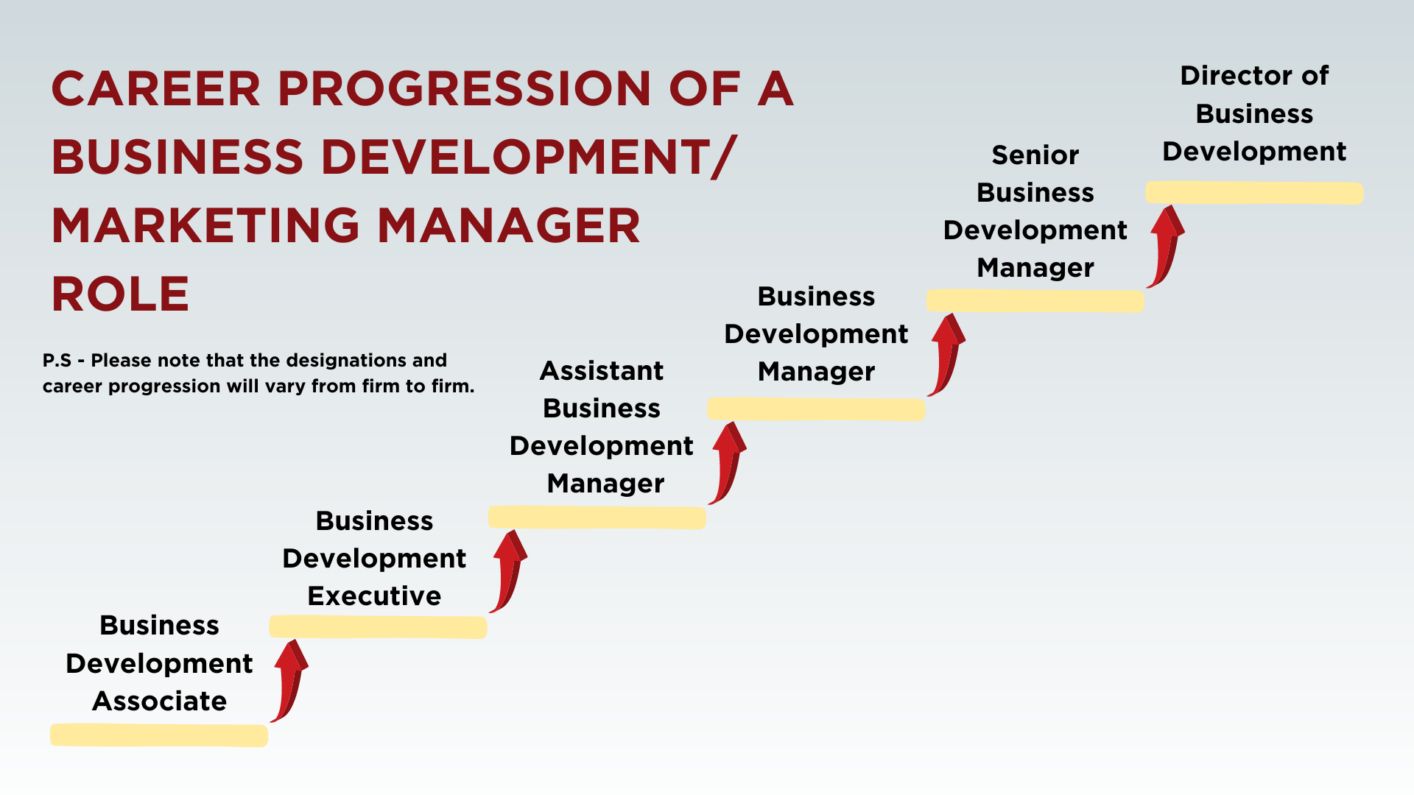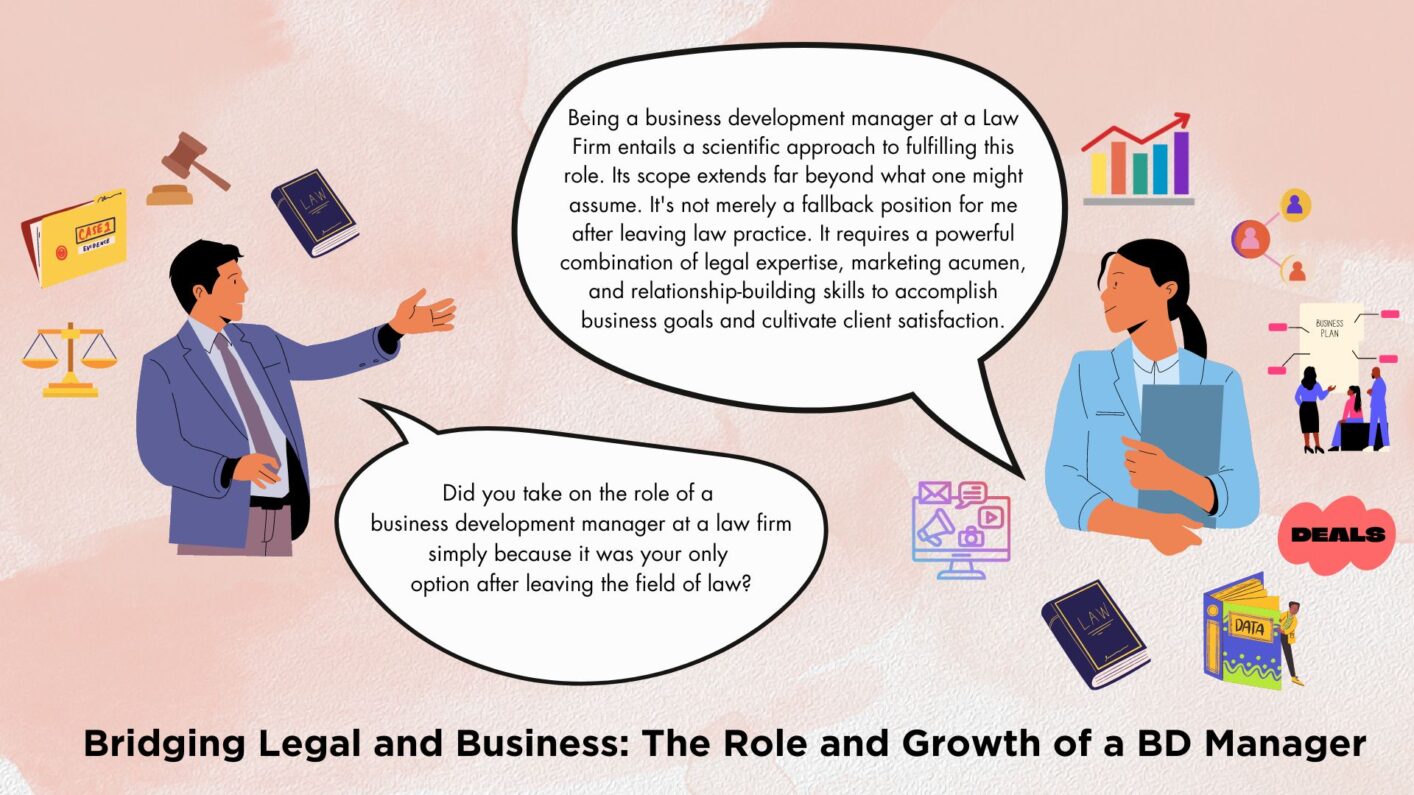We have written about business development at law firms and what is the larger role that the team plays. However, we want to discuss the importance of structuring the business development (BD) and marketing teams/ verticals at a law firm that will not only support the firm’s growth and client acquisition goals but also has a chartered path for the individual’s growth.

P.S – Please note that the designations and career progression will vary from firm to firm. It’s important to review your firm’s growth framework for your vertical and discuss the criteria with your senior to understand their specific expectations and requirements for a BD/ Marketing Manager role.
A firm should bear in mind the following before hiring someone:
- Define Goals and Objectives: Begin by identifying the specific goals and objectives you want to achieve through your BD and marketing efforts. These goals could include increasing client base, expanding into new practice areas, improving brand awareness, or enhancing client retention. Clearly defining your objectives will guide your hiring strategy.
- Build a BD and Marketing Team: Assemble a dedicated team responsible for BD and marketing initiatives. This team may consist of professionals with business development, marketing, communications, and design expertise. Consider the size of your firm and the resources available when determining the size and composition of the team. However, do keep in mind that one person may not be able to fulfill all the functions (the size of your team has nothing to do with it)!
- Develop a Target Market Strategy: Determine your target market and ideal client profile. Understand the industries and sectors in which you want to focus your efforts. This will help you tailor your BD and marketing strategies to attract and retain clients in those areas.
- Will the team/ individual set up a Client Relationship Management (CRM) system: A CRM system will track and manage client interactions, referrals, and business development activities.
- How will you measure and analyse results: Establish key performance indicators (KPIs) to track the success of your BD and marketing initiatives. Monitor website traffic, leads generated, client conversions, and revenue growth metrics. Regularly analyse these results to identify areas of improvement and refine your strategies accordingly.
- Continuous Improvement: BD and marketing efforts require ongoing evaluation and refinement. Staying updated on industry trends and emerging marketing helps adapt strategies accordingly. Seek feedback from clients and internal stakeholders to continually enhance your services and offerings.
Regularly review and adapt your approach to align with changing market dynamics and client needs.

Job description for a BD Manager role:
As a Business Development Manager in a law firm, your role is crucial in driving the firm’s growth, seeding the market with the brand, enhancing client relationships, and expanding the firm’s market presence. You will work closely with partners, lawyers, and other stakeholders to develop and implement effective business development strategies and initiatives. This position requires a strong combination of legal knowledge, marketing, and relationship-building skills to achieve business objectives and foster client satisfaction.
Key Responsibilities:
Business Development Strategy:
- Develop and execute comprehensive business development strategies and plans to drive growth and revenue for the law firm.
- Conduct market research to identify emerging trends, industry insights, and potential business opportunities.
- Collaborate with partners and lawyers to develop strategies for client acquisition, retention, and expansion.
Client Relationship Management:
- Build and maintain strong relationships with existing clients, understanding their legal needs, and identifying opportunities for cross-selling or upselling legal services.
- Serve as a trusted advisor to clients, providing legal solutions, addressing concerns, and ensuring client satisfaction.
- Proactively engage with clients to identify new business opportunities and foster long-term relationships.
RFP’s:
- Collaborate with lawyers to develop persuasive proposals, pitch presentations, and tailored marketing materials.
- Lead the proposal development process, ensuring timely and high-quality submissions.
Competitive Intelligence and Market Analysis:
- Monitor the legal market, including competitors, industry trends, and regulatory changes.
- Conduct competitive analysis to identify market positioning, differentiation strategies, and potential areas for growth.
- Provide regular updates and insights to partners and lawyers on market developments that may impact the firm’s business.
Events, Sponsorships, and Thought Leadership:
- Plan and execute events, seminars, webinars, and conferences to enhance the firm’s visibility and thought leadership.
- Identify relevant sponsorship opportunities and manage relationships with industry associations and organizations.
- Collaborate with senior lawyers to create and promote thought leadership content, including articles, white papers, and presentations.
CRM Management and Reporting:
- Utilize the firm’s Customer Relationship Management (CRM) system to track business development activities, client interactions, and opportunities.
- Prepare regular reports and presentations on business development initiatives, and pipeline status for management reviewAnalyse data to identify trends, evaluate the effectiveness of business development efforts, and provide actionable recommendations.